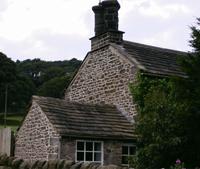The care and repair of our built heritage

The Yorkshire Dales have a stunningly beautiful range of both listed and non-listed buildings, each with its own unique history and stories to tell, writes old and listed building specialist Kevin Woods.
They stand as a tribute to the craftsmanship of our forbears, ranging from imposing castles, stately homes, parish churches and manor houses to simply-built workers’ cottages, field barns and dry-stone walls.
These structures were built with breathability in mind, so any moisture that entered the wall would pass through and evaporate both internally and externally. This has worked well for millennia, not just in the Yorkshire Dales, but all around the world. External walls in older buildings were often covered with Lime render or Lime wash to protect them from the elements. The walls had no cavity, but were solidly built, with through-stones and a rubble infill. In the Dales the roofs would have been either thatched or slated with blue Welsh or green Westmoreland or grey Burlington, and any gaps under the slates were pointed/torched with haired Lime mortar. Internal walls were also plastered with haired Lime plaster, while floors were made of compacted earth, or had stone flags, tiles or raised timber floor boards.
There are many Roman and medieval buildings still standing all over Europe, such as the Coliseum and the Pantheon in Rome, and closer to home, Hadrian’s Wall. The latter was such a well-built structure that, if it was not for the stone robbers, I believe would stand much taller today. As for the medieval era one only has to go to York to see how much of our built heritage remains, proving that structures built with traditional skills and materials do stand the test of time.
Contrary to popular belief, old buildings did work well. The cold was kept at bay by the heat of the fireplace, and damp controlled by regular maintenance. These principles still apply today, so it is essential that older buildings are not maintained with modern, chemically rich, approaches, like damp-proof injections, silicone sealants, plastic paints and cementitous pointing and renders. Such methods are only suitable for modern buildings, for which they were designed in the first place. In old buildings they accelerate the decay by trapping moisture within the fabric. This will eventually cause interior damage, such as plaster decay, mould growth, and timber rot, which can even result in structural collapse. Externally, stone and brickwork and renders will also deteriorate quickly which is often down to a combination of modern materials and the natural freeze-and-thaw cycle.
Lime mortars have the advantage of accommodating movement in buildings contrary to cement mixes which crack and allow moisture into the structure, thus accelerating its decay. Also unlike cement, Lime mortar can be recycled. Moreover stones and bricks can be cleaned off easily and reused when built and pointed with Lime; which is difficult when cement has been used, often resulting in damaging or breaking the brick and stones, thus rendering them useless for the future.
It was mainly from the 1940s onwards that unsuitable quick-fix attitudes were adopted, which generally evolve around modern cements and plastic paints. Quicker, cheaper and less labour-intensive to use, these materials and their related construction techniques took hold and became the norm, while the traditional ways of repair were largely forgotten. During the First and Second World War, many craftsmen were lost and their skills died with them; skills that would have been passed on from father to son, or to future apprentices. Added to this came the vast amount of building work that was needed to rebuild the bombed cities and, later, cater for an ever increasing population. Quicker and cheaper ways of providing new housing or large civil engineering projects were necessary, and cement served this purpose well, and still does so today.
However, these modern materials are not the answer to the survival of our historic buildings which we treasure so much. Thankfully, the importance of Lime and other natural products is now being increasingly recognised, which is great news for our old buildings and the people who live in them. The solution for their repair is straightforward: use traditional methods and materials which are compatible with the existing structure! This will ensure the building’s future by keeping the damp at bay and protecting the fabric. In the end, this is common sense and saves a lot of money in the long term. To succeed, always employ a builder who has understanding and expertise in the construction and repair of historic buildings. Furthermore, knowledge is required for certain statutory requirements that need to be followed, such as Listed Building Consent, which applies to the interior as well as the exterior of any listed building. These measures are set in place to ensure that no valuable features are lost, thus retaining the property’s unique character, which, consequently, will also affect its market value.
At the moment, Lime and other eco-friendly natural products also have a positive future ahead in the new build industry. There are lots of new, exciting and innovative products on the market, such as straw bale construction, sheep wool insulation, clay-tech building blocks, hemp and lime building blocks. If you would like information about these and other products go to www.womersleys.co.uk. Listed below are some useful and relevant organisations for anyone interested in finding out more about the care and repair of our built heritage: Listed Property Owners Club, Funds For Historic Buildings, Society for the Protection of Ancient Buildings, Building Limes Forum, or you can write me an email to This email address is being protected from spambots. You need JavaScript enabled to view it., or alternatively, you can go on my website at www.woodsbuild.co.uk.
















